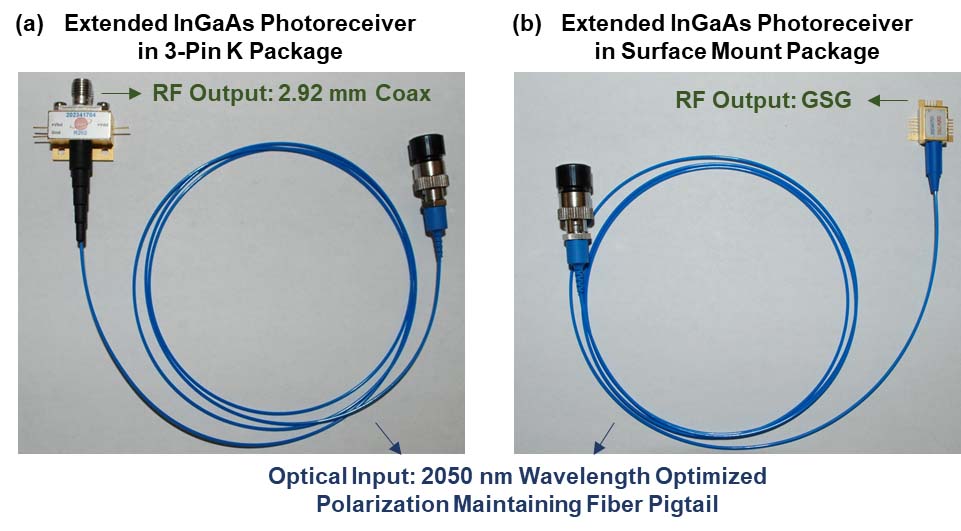|
|

|
Ewing, NJ - August, 2020
Comprehensive space qualification of Extended InGaAs Photodiodes and Photoreceivers with wavelength coverage in the Short Wave Infrared (SWIR) from 1 um to 2.5 um wavelength is needed for multiple space based applications, such as coherent LIDAR having rapid Doppler shifts for wind profiling, direct detection of back-scattered sunlight for spectroscopic sensing, long wavelength gravitational wave sensing, and free-space optical communication links with bandwidths up to 400 Gbps. Although such devices have been commercially available for terrestrial analog and digital applications, significant testing is required beyond MIL-STD-883 and Telcordia Bellcore GR-468 to qualify them for space applications. With this objective in mind, we have undertaken a multi-year effort to qualify Extended InGaAs devices, which includes a combination of comprehensive radiation testing in laboratory as well as space flights.
We have recently reported 2.2 um wavelength, Extended InGaAs Linear Optical Receivers up to 8 GHz bandwidth assembled in fiber-pigtailed, hermetically-sealed microwave package, which have passed several radiation tests, including 30 MeV Protons, 15 krad Gamma Rays, 1 GeV/n He (Helium) ions and 1 GeV/n Fe (Iron) ions, with fluence levels corresponding to 10+ years long space missions [1].
Additionally, we concluded a successful space flight of two similar Extended InGaAs Optical Receivers on-board the International Space Station (ISS) for over 13 months as part of the Materials International Space Station Experiment 9 (MISSE-9) mission, during which they were simultaneously subjected to all aspects of the space environment, including Proton radiation, Galactic Cosmic Rays (GCR), ultra-violet radiation, ultra-high vacuum, and exposure to atomic oxygen. Also, the devices were subjected to shock and mechanical vibrations during the space launch to the ISS, as well as their return to Earth. Both devices were fully operational after their space flight and passed reliability specifications [2].

Photograph of 2.2 Micron Extended InGaAs Optical Receivers that flew to the International Space Station (ISS)
as part of the Materials International Space Station Experiment 9 (MISSE-9) payload.The two Optical Receivers having two different RF packages exhibit bandwidth of 9 GHz or more, and were fiber coupled with a single mode fiber. They were launched in April 2018 to the ISS and returned to Earth in June 2019 for a cumulative time period of over 13 months. During their time on the ISS, we noted the entry and exit points into the South Atlantic Anomaly (SAA) on a daily basis, and thus, recorded the total time the Extended InGaAs Optical Receivers were exposed to it. It has been shown that the exposure to heavy ions and protons, especially during the SAA transit, cause the most failures to electronic components. We also recorded the daily temperatures they were exposed to during their stay on the ISS, as well as the cumulative radiation dose they experienced through a dedicated dosimeter placed in close proximity to the devices. The pre and post flight data was analyzed for dark current, quantum efficiency, bandwidth, bit error rate, and 14 other parameters. This data analysis did not show any major degradation in the performance of the two devices. Additionally, both RF packages, did not suffer any damage due to the mechanical shock and vibration of the space flight, including the launch and return to Earth.
Key Applications:
- Coherent Lightwave Systems
- Environmental Sensing
- Rapid Doppler-Shift LIDAR Measurements
- Space Communications
References:
Discovery Semiconductors is an industry leader in manufacturing ultrafast, high optical power handling InGaAs photodiodes, radio frequency over fiber optical receivers, balanced optical receivers and several other custom products for applications ranging from analog RF links to ultrafast digital communications.
For additional information, including complete product specifications, operational capabilities and pricing, or to discuss your application in detail, please call Discovery at: (609) 434-1311 or fax: (609) 434-1317.